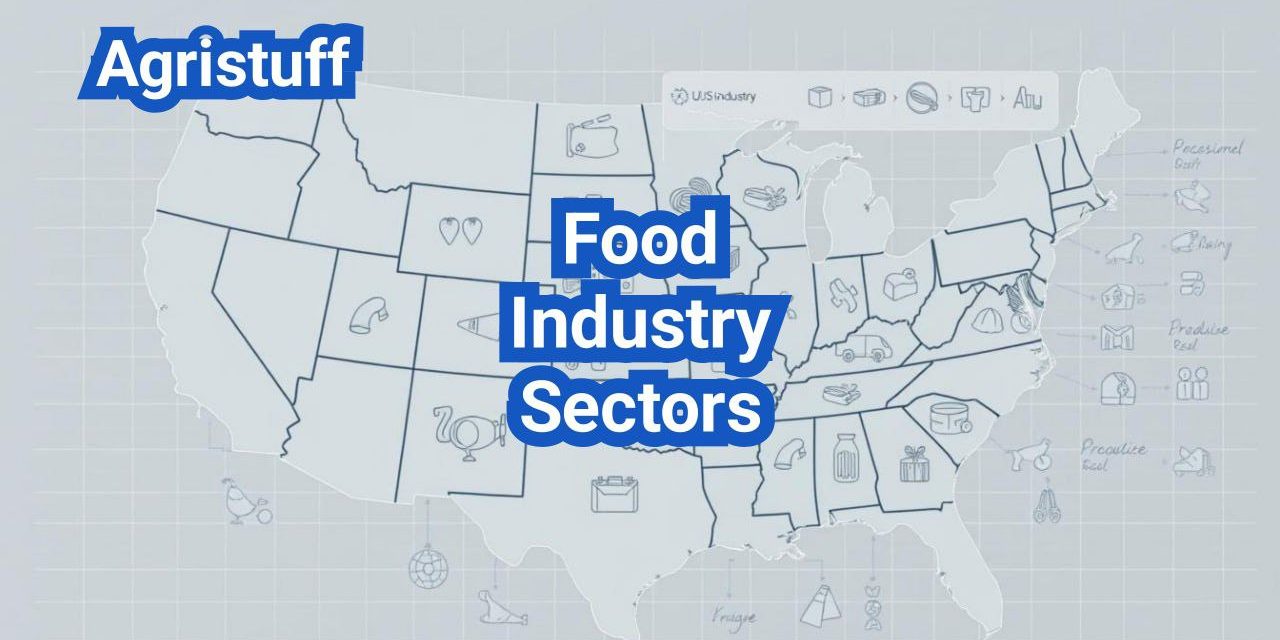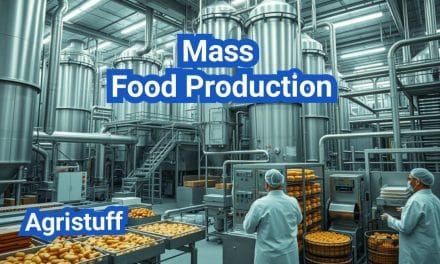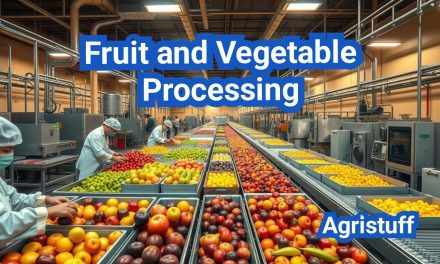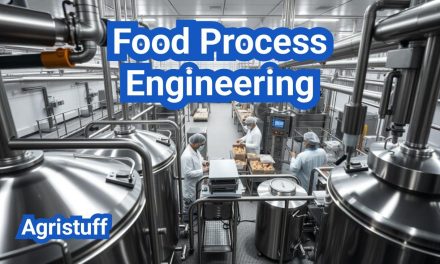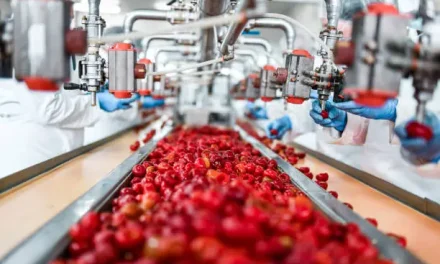The U.S. food industry is a complex and multifaceted sector, encompassing various stages from production to consumption. Understanding the different sectors within this industry is crucial for businesses, policymakers, and consumers.
The industry can be broadly categorized into food manufacturing, beverage manufacturing, foodservice, and retail. Each of these categories has its subsectors and nuances, influenced by factors such as consumer preferences, regulatory frameworks, and economic conditions.
Key Takeaways
- The U.S. food system has evolved significantly due to changes in consumer demand and technological advancements.
- The industry is broadly categorized into food manufacturing, beverage manufacturing, foodservice, and retail.
- Understanding the different sectors is crucial for businesses and policymakers.
- NAICS311 and NAICS3121 are key classifications for food and beverage manufacturing.
- Consumer preferences and regulatory frameworks influence the industry’s subsectors.
The Economic Significance of the U.S. Food Industry
With its substantial contribution to the GDP and employment of a large workforce, the U.S. food industry is a cornerstone of the national economy. The industry’s economic significance extends beyond its direct contributions, influencing various aspects of the economy, including trade, employment, and overall economic stability.
Food Industry GDP and Value Added
The U.S. food industry contributes significantly to the country’s GDP, with the food system’s contribution to GDP being considerable and continuing to grow. According to the USDA, the food industry’s value-added component is substantial, reflecting its importance in the national economy. The value-added aspect of the food industry encompasses various activities, including food processing, manufacturing, and distribution.
Value Added in the Food Industry
| Category | Value Added ($ billion) | Percentage of Total GDP |
|---|---|---|
| Food Processing | 150 | 0.8% |
| Food Manufacturing | 200 | 1.2% |
| Food Distribution | 100 | 0.5% |
Market Size and Growth Trends
The U.S. food industry’s market size is substantial, with various sectors contributing to its overall value. The market has experienced steady growth, driven by factors such as changing consumer preferences, technological advancements, and demographic shifts. Understanding market size and growth trends is essential for analyzing the industry’s dynamics and identifying opportunities for growth.
Major Players and Market Concentration
The U.S. food industry is characterized by the presence of major players, including large food processing and manufacturing companies. Market concentration is a significant aspect of the industry, with a few large companies dominating certain sectors. Understanding the market structure and the role of major players is crucial for analyzing the industry’s competitive landscape.
The major players in the U.S. food industry include companies such as PepsiCo, Tyson Foods, and General Mills, which have significant market shares and influence the industry’s dynamics. The market concentration in certain sectors, such as food processing and manufacturing, can impact competition and innovation.
NAICS Classification: The Blueprint of Food Industry Sectors

The North American Industry Classification System (NAICS) serves as the foundational framework for understanding the diverse sectors within the U.S. food industry. By providing a standardized classification system, NAICS enables businesses, researchers, and policymakers to analyze and understand the complex structure of the food economy.
Understanding the North American Industry Classification System
The NAICS classification system is designed to categorize businesses into different sectors based on their economic activities. In the context of the food industry, NAICS codes help in identifying and analyzing various sectors, from food manufacturing to retail. This classification is crucial for understanding market trends, identifying major players, and conducting market research.
NAICS codes are used to classify businesses into specific categories, allowing for a detailed analysis of the food industry’s structure. By using these codes, stakeholders can gain insights into the economic significance of different sectors within the industry.
How NAICS Codes Structure the Food Economy
NAICS codes play a vital role in structuring the food economy by providing a systematic way to categorize businesses. This categorization helps in understanding the interconnections between different sectors and their contributions to the overall economy. For instance, NAICS codes can be used to analyze the food manufacturing sector, including subsectors like meat processing, dairy manufacturing, and fruit and vegetable preserving.
- NAICS codes facilitate market analysis by providing a standardized framework.
- They help in identifying major players within specific sectors.
- NAICS data is essential for conducting comprehensive market research.
Using NAICS Data for Market Research
NAICS data is a valuable resource for market research, enabling businesses and researchers to analyze market trends, assess competition, and identify growth opportunities. By leveraging NAICS data, stakeholders can gain a deeper understanding of the food industry’s dynamics and make informed decisions.
For example, market research using NAICS data can help businesses identify emerging trends in the food industry, such as the growing demand for organic and specialty foods. This information can be used to develop targeted marketing strategies and expand into new market segments.
Food Manufacturing (NAICS311): Core Production Activities
The food manufacturing sector, classified under NAICS 311, is a vital component of the U.S. food industry, transforming raw ingredients into consumable products. This sector is fundamental to the nation’s food system, contributing significantly to the economy and employing a substantial workforce.
Scope and Definition of Food Manufacturing
Food manufacturing encompasses a wide range of activities, from processing and packaging to preserving food products. It involves the transformation of raw ingredients into intermediate or final products for consumption. According to the USDA, food manufacturing is a significant contributor to the overall value of the U.S. food industry.
Key Activities in Food Manufacturing:
- Processing raw ingredients
- Packaging and labeling products
- Preserving food through various methods
Key Subsectors Within NAICS311
NAICS 311 is further divided into several subsectors, each focusing on specific types of food products. Some of the key subsectors include:
| Subsector | Description |
|---|---|
| Animal Food Manufacturing | Production of food for animals, including pet food |
| Grain and Oilseed Milling | Processing grains and oilseeds into flour, oil, and other products |
| Fruit and Vegetable Preserving | Preserving fruits and vegetables through canning, freezing, and dehydrating |
As noted by industry experts, “The diversity within NAICS 311 allows for a robust and resilient food manufacturing sector, capable of adapting to changing consumer demands and market trends.”
“The food manufacturing industry is a cornerstone of the U.S. economy, providing essential products while driving innovation and employment.”
Economic Impact and Employment Statistics
Food manufacturing has a significant economic impact, contributing to the GDP and providing employment opportunities across various regions. According to the Bureau of Labor Statistics, the food manufacturing sector employs a substantial workforce, with varying wage trends across different subsectors.
The economic impact of food manufacturing is multifaceted, influencing not only the food industry but also related sectors such as agriculture and transportation. Understanding the dynamics of this sector is crucial for analyzing the overall food industry’s performance and identifying opportunities for growth.
Beverage Manufacturing Sector (NAICS3121)
With a broad spectrum of beverages, from juices and soft drinks to beers and wines, the beverage manufacturing sector plays a crucial role in the U.S. market. This sector is characterized by its diversity, encompassing both non-alcoholic and alcoholic beverages that cater to a wide range of consumer preferences.
Alcoholic vs. Non-Alcoholic Beverage Production
The beverage manufacturing sector is divided into two main categories: alcoholic and non-alcoholic beverages. Non-alcoholic beverages include soft drinks, juices, and bottled water, which are produced by companies like Coca-Cola and PepsiCo. On the other hand, alcoholic beverages comprise beers, wines, and spirits, produced by breweries, wineries, and distilleries.
Market Trends and Major Players
The beverage industry is subject to various market trends, including the growing demand for healthier and more sustainable beverages. Major players in the sector are adapting to these trends by innovating their product lines. For instance, companies are introducing low-calorie drinks and beverages made with natural ingredients.
Some of the major players in the U.S. beverage manufacturing sector include The Coca-Cola Company, PepsiCo, Anheuser-Busch InBev, and Constellation Brands. These companies are not only market leaders but also influencers of consumer preferences and industry trends.
Regulatory Considerations for Beverage Manufacturers
Beverage manufacturers must comply with a range of regulations, including those related to food safety, labeling, and advertising. The Alcohol and Tobacco Tax and Trade Bureau (TTB) regulates alcoholic beverages, while the Food and Drug Administration (FDA) oversees non-alcoholic beverages.
Regulatory considerations also include environmental regulations and laws related to packaging and waste management. Companies must navigate these regulations to ensure compliance and maintain their market presence.
Primary Food Industry Sectors in the U.S. Market

The U.S. food industry is diverse, with several key sectors driving its economy. These sectors are fundamental to the production and processing of food products, contributing significantly to the overall value of the industry.
Meat and Poultry Processing Sector
The meat and poultry processing sector is a significant component of the U.S. food industry. It involves the processing and packaging of meat and poultry products for consumption. This sector is characterized by large-scale operations and is subject to stringent regulations to ensure food safety.
According to the USDA, the meat and poultry processing sector has seen significant developments in technology, leading to improved efficiency and reduced costs. Major companies in this sector include Tyson Foods and JBS USA.
Dairy Manufacturing and Markets
Dairy manufacturing is another crucial sector, involving the production of dairy products such as milk, cheese, and yogurt. The dairy industry is influenced by factors such as milk production levels, consumer demand, and global market trends.
The U.S. dairy market is competitive, with major players like Dairy Farmers of America and Land O’Lakes. The sector is also subject to regulations by the FDA and USDA.
Grain and Oilseed Milling (NAICS3112)
The grain and oilseed milling sector is vital for processing grains and oilseeds into products like flour, cornmeal, and vegetable oils. This sector is influenced by agricultural production levels and global demand for grain products.
Companies like Archer Daniels Midland and General Mills play significant roles in this sector. The grain and oilseed milling industry is subject to fluctuations in commodity prices and trade policies.
Seafood Processing in the U.S.
Seafood processing involves the preparation and packaging of seafood products for consumption. The U.S. seafood processing industry is diverse, with a range of products including canned fish, frozen seafood, and smoked fish.
The sector is influenced by factors such as fishing regulations, consumer preferences, and global market trends. Major companies in this sector include Bumble Bee Foods and Tri-Union Seafoods.
Specialty and Value-Added Food Manufacturing
Specialty and value-added food manufacturing represents a dynamic segment of the U.S. food industry, characterized by the production of high-value and distinctive products. This sector is driven by consumer demand for premium, artisanal, and unique food items, which has led to significant growth and innovation within the industry.
Bakery and Tortilla Products (NAICS 3118)
The bakery and tortilla products subsector is a significant component of specialty food manufacturing. It encompasses a wide range of products, from traditional bread and pastries to specialty tortillas and baked goods. The demand for artisanal and gourmet bakery products has been on the rise, driven by consumers seeking authentic and high-quality food experiences.
Key trends in the bakery and tortilla products sector include:
- Increasing demand for gluten-free and specialty baked goods
- Growth in the tortilla market driven by the popularity of Mexican cuisine
- Rise of artisanal bakeries and in-store bakeries in retail environments
Sugar and Confectionery Products (NAICS 3113)
The sugar and confectionery products manufacturing subsector produces a variety of sweet treats, including chocolates, candies, and other confectionery items. This sector is known for its innovation in product development, with manufacturers constantly introducing new flavors, textures, and packaging to attract consumers.
Notable trends in the sugar and confectionery products sector include:
- Premiumization of chocolate products with high cocoa content
- Increasing demand for healthier and better-for-you confectionery options
- Growing popularity of e-commerce channels for confectionery sales
| Subsector | NAICS Code | Key Products | Market Trends |
|---|---|---|---|
| Bakery and Tortilla Products | 3118 | Bread, pastries, tortillas, specialty baked goods | Gluten-free, artisanal, gourmet |
| Sugar and Confectionery Products | 3113 | Chocolates, candies, other confectionery | Premiumization, healthier options, e-commerce growth |
Fruit and Vegetable Preserving (NAICS 3114)
The fruit and vegetable preserving subsector involves the processing and preservation of fruits and vegetables through various methods such as canning, freezing, and dehydrating. This sector is crucial for making seasonal produce available year-round and for providing consumers with convenient and nutritious food options.
The fruit and vegetable preserving industry is adapting to consumer trends by offering more organic and non-GMO products, as well as products with reduced sodium and sugar content. Manufacturers are also investing in sustainable packaging solutions to reduce environmental impact.
The Distribution Chain: Connecting Production to Consumption

The distribution chain serves as the backbone of the U.S. food industry, facilitating the flow of goods from production to consumption. It encompasses various channels and stakeholders that work together to ensure that food products reach consumers efficiently.
Grocery Wholesalers (NAICS4244)
Grocery wholesalers play a crucial role in the distribution chain by acting as intermediaries between food manufacturers and retailers. They purchase products in bulk, store them in warehouses, and then distribute them to retailers. According to the U.S. Census Bureau, the grocery wholesaling industry has seen significant changes with the rise of e-commerce, adapting to new demands and logistical challenges.
Key activities of grocery wholesalers include:
- Bulk purchasing and storage
- Inventory management
- Logistics and transportation
- Supply chain coordination
Food Retail Market (NAICS445)
The food retail market is another vital component of the distribution chain, directly serving consumers through various retail formats such as supermarkets, convenience stores, and specialty food stores. The retail landscape has evolved with changing consumer preferences, including a shift towards online shopping and home delivery services.
Trends in the food retail market include:
- Increased demand for online grocery shopping
- Expansion of meal kit delivery services
- Enhanced in-store experiences
Direct-to-Consumer and E-commerce Channels
The rise of e-commerce has significantly impacted the distribution chain, with more consumers turning to online platforms to purchase food. Direct-to-consumer models allow producers to sell their products directly to consumers, bypassing traditional retail channels. This shift has opened new opportunities for small and medium-sized producers to reach a wider market.
The integration of e-commerce in the food industry has also led to innovations in logistics and delivery systems, ensuring that products are delivered fresh and on time. As consumer preferences continue to evolve, the distribution chain will need to adapt to meet these changing demands.
Foodservice vs. Retail Channels: Understanding Market Dynamics

Understanding the differences between foodservice and retail channels is crucial for analyzing consumer spending patterns in the U.S. food industry. The distinction between these channels not only affects how food is consumed but also influences the overall market trends and industry structure.
Food-at-Home (FAH) Market Structure
The Food-at-Home (FAH) market refers to the retail channel where consumers purchase food to be consumed at home. This market is characterized by grocery stores, supermarkets, and online retailers. The FAH market has seen significant growth, driven by consumer preferences for convenience and quality.
Key players in the FAH market include: Walmart, Kroger, and Amazon. These retailers have adapted to changing consumer behaviors by enhancing their online shopping experiences and offering various delivery options.
Food-Away-From-Home (FAFH) Sector Analysis
The Food-Away-From-Home (FAFH) sector encompasses restaurants, cafes, and other foodservice establishments where consumers eat out or order food for takeout. The FAFH sector is influenced by consumer dining preferences, economic conditions, and demographic trends.
Trends in the FAFH sector: There’s been a rise in demand for healthy and sustainable dining options, as well as an increase in online ordering and delivery services, driven in part by the growth of food delivery apps like Uber Eats and DoorDash.
The Food Expenditure Series: Tracking Consumer Spending
The Food Expenditure Series provides valuable insights into how consumers allocate their food spending between FAH and FAFH channels. This data is crucial for understanding market dynamics and consumer behavior.
| Year | FAH Expenditure ($ Billion) | FAFH Expenditure ($ Billion) |
|---|---|---|
| 2019 | 734.6 | 863.4 |
| 2020 | 814.2 | 643.1 |
| 2021 | 844.9 | 734.5 |
COVID-19 Impact on Channel Distribution
The COVID-19 pandemic significantly impacted the distribution of food expenditure between FAH and FAFH channels. With widespread lockdowns and dining restrictions, consumers shifted their spending towards FAH, resulting in a surge in grocery sales.
The pandemic highlighted the resilience and adaptability of the food industry, with both FAH and FAFH channels evolving to meet changing consumer needs. As the industry continues to recover, understanding these dynamics will be essential for stakeholders across the food supply chain.
Regulatory Framework Governing Food Industry Sectors

The U.S. food industry is subject to a comprehensive regulatory framework that encompasses a wide range of regulations and oversight by different governmental bodies. This complex landscape is designed to ensure food safety, quality, and compliance with various standards.
FSIS vs. FDA Jurisdiction: Who Regulates What
The Food Safety and Inspection Service (FSIS) and the Food and Drug Administration (FDA) are the two primary agencies responsible for regulating the U.S. food industry. The FSIS has jurisdiction over meat, poultry, and egg products, while the FDA regulates all other food products, including dairy, produce, and processed foods.
Understanding the jurisdictional boundaries between FSIS and FDA is crucial for food manufacturers to ensure compliance with relevant regulations. For instance, companies producing meat products must adhere to FSIS guidelines, whereas those manufacturing dairy or produce products fall under FDA oversight.
Key Regulatory Responsibilities:
- FSIS: Meat, poultry, and egg products
- FDA: Dairy, produce, processed foods, and other non-meat products
FSMA Preventive Controls (21 CFR117)
The Food Safety Modernization Act (FSMA) Preventive Controls rule (21 CFR 117) is a critical regulation that mandates food facilities to implement preventive controls to minimize or prevent hazards that could cause foodborne illnesses. This regulation applies to both human and animal food facilities.
Preventive controls include:
- Implementing a food safety plan
- Conducting hazard analyses
- Implementing process controls
- Maintaining sanitation controls
- Supply chain controls
FDA Food Code for Retail & Restaurants
The FDA Food Code provides a model for ensuring food safety in retail and foodservice establishments. It covers aspects such as food handling, storage, preparation, and disposal, as well as employee health and hygiene practices.
“The FDA Food Code is a critical tool for state, local, and tribal agencies to ensure food safety in retail and foodservice settings, thereby protecting public health.” – FDA
State and Local Regulatory Considerations
In addition to federal regulations, food industry businesses must comply with state and local regulations, which can vary significantly. These regulations may include specific requirements for food handling, labeling, and facility operations.
| Regulatory Level | Key Aspects |
|---|---|
| Federal | FSIS and FDA regulations, FSMA |
| State | Food handling, labeling, facility operations |
| Local | Health department regulations, zoning laws |
Navigating this complex regulatory landscape requires a thorough understanding of federal, state, and local regulations. By staying informed and compliant, businesses in the U.S. food industry can ensure the safety and quality of their products, ultimately protecting public health.
Economic Analysis: The Food Dollar Breakdown

The decomposition of the food dollar into its constituent parts is crucial for comprehending the industry’s economic landscape. This breakdown provides a comprehensive view of how the value of food is distributed across different stages of the supply chain, from primary production to value-added services.
Value Chain Distribution
The value chain distribution within the food industry is complex, involving various stakeholders and activities. It encompasses the entire journey of food products, from farm production to processing, packaging, distribution, and finally, to consumption. Understanding this distribution is key to analyzing the economic dynamics of the industry.
Primary Production vs. Value-Added Services
A critical aspect of the food dollar breakdown is the distinction between primary production and value-added services. Primary production refers to the initial stage of food production, such as farming and livestock rearing. In contrast, value-added services include processing, packaging, and marketing activities that enhance the value of the raw products. The interplay between these two segments significantly influences the overall economic performance of the food industry.
Farm Share vs. Marketing Share
The food dollar breakdown also highlights the division between the farm share and the marketing share. The farm share represents the proportion of the food dollar that goes to farmers for their produce, while the marketing share includes the costs associated with getting the product to the consumer, such as processing, transportation, and retailing. Analyzing these shares provides insights into the profitability and challenges faced by different segments of the food industry.
By examining the food dollar breakdown, stakeholders can gain a deeper understanding of the economic forces at play in the food industry. This knowledge can inform strategic decisions, policy-making, and investment choices, ultimately contributing to a more efficient and resilient food system.
Labor and Employment Across Food Industry Sectors
The food industry in the United States employs a substantial number of workers across different sectors. Understanding the labor market dynamics is crucial for analyzing the industry’s overall performance and future prospects.
BLS Employment Statistics by Sector
The Bureau of Labor Statistics (BLS) provides comprehensive data on employment trends across various food industry sectors. According to BLS statistics, the food manufacturing sector alone employs over 1.5 million workers. The data highlights the significance of the food industry as a major employer in the U.S. economy.
Key employment statistics include:
- Food manufacturing: 1.5 million employees
- Foodservice and drinking places: over 12 million employees
- Grocery stores: approximately 2.5 million employees
Wage Trends and Regional Variations
Wage trends in the food industry vary significantly across different sectors and regions. The BLS data indicates that certain sectors, such as specialty food manufacturing, tend to offer higher wages compared to others like foodservice.
Regional variations are also notable:
- States with higher costs of living, such as California and New York, often have higher average wages.
- Rural areas may have lower wage rates compared to urban centers.
Labor Challenges and Future Workforce Needs
The food industry faces several labor challenges, including workforce shortages and the need for skilled labor. Addressing these challenges is crucial for the industry’s future growth and sustainability.
Key labor challenges include:
- Labor shortages in certain sectors, such as food manufacturing and foodservice.
- The need for training programs to develop skilled workers.
- Compliance with labor regulations and standards.
Technology and Innovation Transforming Food Sectors

The U.S. food industry is on the cusp of a technological revolution, driven by innovations in automation, food safety, and sustainability. This transformation is not only enhancing operational efficiency but also addressing consumer demands for safer, more sustainable products.
Automation in Food Processing and Manufacturing
Automation is revolutionizing food processing and manufacturing by increasing efficiency, reducing labor costs, and improving product consistency. Robotics and machine learning algorithms are being integrated into production lines to perform tasks that were previously manual, such as sorting, packaging, and quality control.
For instance, robotic pick-and-place systems are being used in bakeries to handle delicate pastries, while automated sorting machines are improving the efficiency of fruit and vegetable processing. These technologies not only reduce the risk of contamination but also enable producers to meet the growing demand for processed and packaged foods.
Food Safety and Traceability Technologies
Food safety remains a paramount concern for the industry, with consumers increasingly demanding transparency regarding the origin and handling of their food. Technologies such as blockchain, IoT sensors, and advanced tracking systems are being adopted to enhance traceability and ensure compliance with safety regulations.
Blockchain technology, for example, allows for the creation of an immutable record of a product’s journey from farm to table, enabling quick identification of contamination sources in the event of a recall. IoT sensors, on the other hand, monitor conditions such as temperature and humidity during transportation and storage, ensuring that products remain within safe parameters.
| Technology | Application | Benefit |
|---|---|---|
| Blockchain | Traceability | Enhanced transparency and quick recall response |
| IoT Sensors | Monitoring conditions | Ensures safe storage and transportation |
| Automated Sorting | Quality Control | Reduces contamination risk and improves efficiency |
Sustainability Innovations and Green Manufacturing
Sustainability is becoming a core focus for food manufacturers, driven by consumer preferences and regulatory pressures. Innovations such as energy-efficient equipment, waste reduction technologies, and sustainable packaging are being adopted to minimize environmental impact.
For example, some manufacturers are implementing anaerobic digestion systems to convert waste into energy, reducing their reliance on fossil fuels. Others are developing packaging solutions that are biodegradable or made from recycled materials, reducing plastic waste.
These sustainability innovations not only contribute to a more environmentally friendly food industry but also offer cost savings and compliance with increasingly stringent environmental regulations.
How to Navigate Business Opportunities Across Food Industry Sectors
To succeed in the U.S. food industry, businesses must be adept at identifying and capitalizing on emerging opportunities across its diverse sectors. The industry’s complexity, with its various segments and sub-sectors, requires a strategic approach to navigate its many facets effectively.
Identifying Market Gaps and Growth Areas
One of the key steps in navigating business opportunities is identifying market gaps and growth areas. This involves analyzing consumer trends, market demand, and competitor activity to pinpoint areas where new products or services can be introduced or where existing ones can be improved.
Market research plays a crucial role in this process, enabling businesses to understand consumer preferences, track market trends, and assess the competitive landscape.
- Analyze consumer trends and preferences
- Assess market demand and competitor activity
- Identify areas for innovation and growth
For instance, the growing demand for plant-based products has created new opportunities for businesses in the food industry. Companies that have adapted to this trend by introducing plant-based options have seen significant growth.
Understanding Sector-Specific Entry Requirements
Each sector within the food industry has its own set of entry requirements, including regulatory compliance, production standards, and distribution networks. Understanding these requirements is essential for businesses looking to enter or expand within a particular sector.
| Sector | Regulatory Compliance | Production Standards |
|---|---|---|
| Meat and Poultry Processing | FSIS regulations | HACCP standards |
| Dairy Manufacturing | FDA regulations | Sanitation and safety protocols |
| Specialty Foods | FDA and state regulations | Quality control measures |
Developing Cross-Sector Business Strategies
Developing business strategies that span multiple sectors can help companies diversify their offerings and reduce dependence on a single market. This involves identifying synergies between different sectors and leveraging them to create new opportunities.
Cross-sector collaboration can lead to innovative products and services that meet the evolving needs of consumers. For example, collaborations between food manufacturers and technology companies have led to the development of smart packaging and other innovations.
By understanding the intricacies of the food industry’s various sectors and developing strategies to navigate them, businesses can capitalize on emerging opportunities and achieve success in this complex and multifaceted market.
The Interconnected Future of Food Industry Sectors
The U.S. food industry is a complex and interconnected system, with various sectors influencing one another. Understanding these dynamics is essential for analyzing the industry’s overall structure and future prospects.
As the industry continues to evolve, businesses and policymakers must consider the interconnected nature of the food industry sectors to make informed decisions. The interconnected future of the U.S. food industry will be shaped by the interactions between different sectors, including food manufacturing, beverage production, and distribution channels.
Industry analyses highlight the importance of understanding the dynamics between different sectors in the U.S. food industry. By recognizing the interdependencies within the industry, stakeholders can better navigate the challenges and opportunities that arise in this complex landscape.
The future of the U.S. food industry will be characterized by its ability to adapt to changing consumer demands, technological innovations, and regulatory requirements. As the industry continues to grow and evolve, its interconnected future will be shaped by the collaborative efforts of various stakeholders across different food industry sectors.
FAQ
What are the primary sectors within the U.S. food industry?
The primary sectors within the U.S. food industry include food manufacturing, beverage manufacturing, foodservice, and retail. Each of these categories has its subsectors and nuances, influenced by factors such as consumer preferences, regulatory frameworks, and economic conditions.
How is the U.S. food industry classified using NAICS codes?
The U.S. food industry is classified using NAICS codes, which categorize businesses into specific sectors. NAICS codes help in analyzing market trends, identifying major players, and conducting market research.
What is the economic significance of the U.S. food industry?
The U.S. food industry is a major contributor to the country’s GDP and a significant employer. The industry’s market size is substantial, with various sectors contributing to its overall value.
What are the key subsectors within food manufacturing (NAICS311)?
Key subsectors within food manufacturing include meat and poultry processing, dairy manufacturing, grain and oilseed milling, and seafood processing. These subsectors are critical components of the U.S. food industry.
How does the beverage manufacturing sector (NAICS3121) operate?
The beverage manufacturing sector encompasses both alcoholic and non-alcoholic beverages. Understanding market trends, major players, and regulatory considerations is crucial for businesses operating within this sector.
What is the role of grocery wholesalers (NAICS4244) in the distribution chain?
Grocery wholesalers play a vital role in the distribution chain, connecting food production to consumption. They supply food products to retailers, foodservice providers, and other businesses.
How do foodservice and retail channels differ?
Foodservice and retail channels differ in their market dynamics, with foodservice focusing on prepared meals consumed away from home and retail focusing on packaged goods for home consumption.
What is the impact of COVID-19 on the U.S. food industry?
COVID-19 has significantly impacted the U.S. food industry, affecting consumer spending patterns, supply chain dynamics, and the overall market structure.
What regulatory frameworks govern the U.S. food industry?
The U.S. food industry is governed by various federal, state, and local regulations, including FSMA preventive controls and the FDA Food Code. Understanding these regulations is essential for businesses operating within the industry.
How does the food dollar breakdown provide insights into the industry’s economic dynamics?
The food dollar breakdown provides insights into the distribution of value across different stages of the supply chain, from primary production to value-added services.
What are the labor and employment trends in the U.S. food industry?
Labor and employment trends in the U.S. food industry vary across sectors, with some experiencing labor shortages and others facing wage stagnation.
How is technology transforming the U.S. food industry?
Technology is driving significant changes in the U.S. food industry, from automation in food processing and manufacturing to advancements in food safety and traceability technologies.
How can businesses navigate opportunities across food industry sectors?
Businesses can navigate opportunities by identifying market gaps, understanding sector-specific entry requirements, and developing cross-sector business strategies.
Conclusion of: Food Industry Sectors
Why understanding food industry sectors is a strategic advantage
Understanding food industry sectors gives you the map of who produces, who distributes, and who sells food in the U.S.—and under which rulebook. When you know the lines between farm inputs, processors, wholesalers, retailers, and foodservice, you can size markets, plan compliance, and choose the best channels. In short, mastering the layout of food industry sectors turns complexity into clarity and helps your brand move from idea to shelf with fewer surprises. USDA ERS: Food & Beverage Manufacturing overview
How the U.S. classifies food industry sectors (NAICS at a glance)
Economists and regulators classify food industry sectors using the NAICS system: 311 (Food Manufacturing), 3121 (Beverage), 4244 (Grocery & Related Wholesalers), 445 (Food & Beverage Retailers), and 722 (Food Services & Drinking Places). Using these codes across food industry sectors keeps data, policy, and investment analysis aligned—so your reporting and benchmarking match official statistics. Census: NAICS 311 (Food Manufacturing)
Why segmentation matters across food industry sectors
Clear segmentation of food industry sectors lets leaders quantify value added, jobs, wages, and productivity by stage—manufacturing versus wholesale, retail, or restaurants. This clarity helps budgets, capital plans, and M&A models reflect the economics of each link in food industry sectors, rather than averaging away critical differences. BEA: GDP by Industry
Food manufacturing is the backbone of food industry sectors (NAICS 311)
Within U.S. food industry sectors, NAICS 311 transforms raw agricultural commodities into branded and private-label products at scale. Plants cover animal slaughtering, dairy, grain & oilseed milling, bakeries, confectionery, snacks, and specialty items—each with its own processes, hazards, and workforce—making this branch central to all food industry sectors. BLS: Food Manufacturing (311)
What’s largest inside food industry sectors (meat, dairy & more)
Among U.S. food industry sectors, meat processing is typically the largest by value added and employment, followed by dairy, beverages, and grain & oilseed milling. Knowing which sub-sectors lead helps suppliers, innovators, and investors prioritize opportunities and de-risk decisions across food industry sectors. USDA ERS: Meat processing leads (shares)
How big is the processing footprint in food industry sectors?
Scale matters in food industry sectors: tens of thousands of U.S. food and beverage processing establishments operate nationwide, with big clusters in California, Texas, and New York. This dispersion drives logistics planning, talent pipelines, and supplier networks across all food industry sectors. USDA ERS: Establishments & geography
Beverage manufacturing as its own branch of food industry sectors (NAICS 3121)
Soft drinks, bottled water, breweries, and wineries anchor a specialized branch of food industry sectors. Alcoholic beverages face TTB labeling/approval, while non-alcoholic beverages fall primarily under FDA—jurisdiction lines that shape formulation, claims, and timelines within food industry sectors. TTB: Alcohol Beverage Labeling
USDA FSIS vs. FDA: the key jurisdiction split in food industry sectors
A defining feature of U.S. food industry sectors is inspection and enforcement: USDA’s FSIS regulates meat, poultry, and certain egg products (with continuous inspection), while FDA oversees most other foods. Misreading this line can delay launches and recalls across food industry sectors. USDA FSIS: Jurisdiction directive
FSMA & cGMPs: the baseline for most food industry sectors
For most food industry sectors, the FDA’s Preventive Controls rule (21 CFR 117) requires hazard analysis, preventive controls, supplier verification, and recall plans—codifying risk-based safety from plant floor to shipment. Understanding this baseline keeps operations compliant across food industry sectors. FDA: FSMA Preventive Controls (21 CFR 117)
Grain & oilseed milling (NAICS 3112): inputs that feed many food industry sectors
Flour mills, corn wet mills, oilseed crushers, and breakfast cereal makers supply essential inputs across food industry sectors. Their process stability, specification control, and commodity risk management ripple through bakeries, snacks, and packaged foods in all food industry sectors. Census: NAICS 3112 (Grain & Oilseed Milling)
Dairy manufacturing (NAICS 3115): from fluid milk to high-value categories
Another cornerstone of U.S. food industry sectors is dairy manufacturing—cheese, yogurt, butter, milk powders, and ice cream—each with unique chilling, culturing, and sanitation needs. Market signals and federal orders here affect pricing and planning across many food industry sectors. USDA ERS: Dairy Data portal
Seafood processing (NAICS 3117): coastal but critical to national food industry sectors
Seafood processing in U.S. food industry sectors concentrates in coastal states but supplies retail and restaurants nationwide through cold chain networks. Sustainability, imports, and traceability are central themes touching multiple food industry sectors. NOAA: Fisheries & seafood overview
Wholesale (NAICS 4244): the connector across food industry sectors
Grocery and related wholesalers aggregate goods, manage inventory, and move products from plants to stores and restaurants—quietly making food industry sectors work day to day. Pricing, service levels, and fill rates here can make or break brand momentum across food industry sectors. Census: NAICS 4244 (Grocery Wholesalers)
Retail (NAICS 445): the consumer-facing side of food industry sectors
Supermarkets, club stores, specialty shops, and convenience stores are where many food industry sectors meet the shopper. Category resets, private label growth, and shrink reduction shape planograms, promotions, and margins in these food industry sectors. BLS: Food & Beverage Stores (445)
Foodservice (NAICS 722): restaurants, cafeterias, and bars
Restaurants, cafeterias, caterers, and bars form the “food-away-from-home” channel within food industry sectors. Menu engineering, delivery models, and labor costs here shift upstream demand patterns for processors and wholesalers across food industry sectors. BLS: Food Services & Drinking Places (722)
Follow the money: where Americans spend across food industry sectors
Spending data show which food industry sectors will grow. In recent years, the food-away-from-home share reached record highs, signaling strong restaurant demand—vital context for capacity and channel decisions across food industry sectors. USDA ERS: Food Expenditure Series
The food dollar: understanding cost structure in food industry sectors
The ERS Food Dollar Series breaks a retail food dollar into shares for labor, packaging, transportation, energy, and more across food industry sectors. This lens helps teams negotiate supplier contracts, target waste, and focus productivity investments within food industry sectors. USDA ERS: Food Dollar documentation
FDA Food Code: the retail & restaurant playbook in food industry sectors
At the consumer end of food industry sectors, the FDA Food Code is the model many states adopt to keep food safe in retail and foodservice. Aligning with it reduces illness risk and standardizes procedures across food industry sectors. FDA: Summary of 2022 Food Code
Public health stakes across food industry sectors
Why the rules matter in food industry sectors: CDC estimates millions of U.S. foodborne illnesses annually, informing prevention priorities from manufacturing to restaurants. These facts justify robust HACCP, allergen controls, and sanitation across all food industry sectors. CDC: Burden of Foodborne Illness (Q&A)
Labor and skills profiles vary widely in food industry sectors
Maintenance technicians in milling, quality managers in dairy, CDL drivers in wholesale, and food safety leaders in retail—talent needs differ across food industry sectors. Understanding wage levels and occupational mix helps with recruiting, training, and retention across all food industry sectors. BLS OEWS: Food Manufacturing occupations
Strategy tip: align channels and pack sizes within food industry sectors
Channel economics differ across food industry sectors: restaurants are labor-intensive while retail emphasizes packaging and distribution efficiency. Choose pack sizes, price points, and promotions that fit your channel mix across food industry sectors. USDA ERS: FAH vs. FAFH cost shares
Compliance checklist for new entrants in food industry sectors
Before launching in any food industry sectors, map obligations early: FDA Preventive Controls for most foods, USDA FSIS for meat/poultry/egg products, and TTB for alcoholic beverages. Early alignment minimizes rework, holds, and recall exposure across food industry sectors. FDA: FSMA rules & guidance
Quick glossary: common labels you’ll hear across food industry sectors
Expect these tags across food industry sectors: 311 (Food Manufacturing), 3121 (Beverage), 4244 (Grocery Wholesalers), 445 (Food & Beverage Retailers), and 722 (Foodservice). Using them consistently aligns strategy, analytics, and reporting across food industry sectors. Census: NAICS portal
Final thought
If there’s one takeaway about U.S. food industry sectors, it’s that structure predicts outcomes: consumer spending patterns steer growth, jurisdiction defines the rulebook, and value creation depends on where you sit—from milling to plants to retail and restaurants. Treat the layout of food industry sectors as your roadmap to execution, compliance, and growth. USDA ERS: Explore food spending data
Sources & References
- USDA ERS — Food & Beverage Manufacturing
- USDA ERS — Meat processing leads U.S. food & beverage manufacturing
- BEA — GDP by Industry
- BLS — Food Manufacturing (311)
- BLS — Food & Beverage Stores (445)
- BLS — Food Services & Drinking Places (722)
- Census — NAICS 311 (definition)
- Census — NAICS 3112 (Grain & Oilseed Milling)
- Census — NAICS 4244 (Grocery & Related Wholesalers)
- Census — NAICS portal
- USDA ERS — Food Expenditure Series
- USDA ERS — Food Dollar Series documentation
- FDA — 2022 Food Code summary
- CDC — Burden of Foodborne Illness (Q&A)
- TTB — Alcohol beverage labeling
- FDA — FSMA Preventive Controls for Human Food
- FDA — FSMA rules & guidance overview
- BLS OEWS — Food Manufacturing occupations

